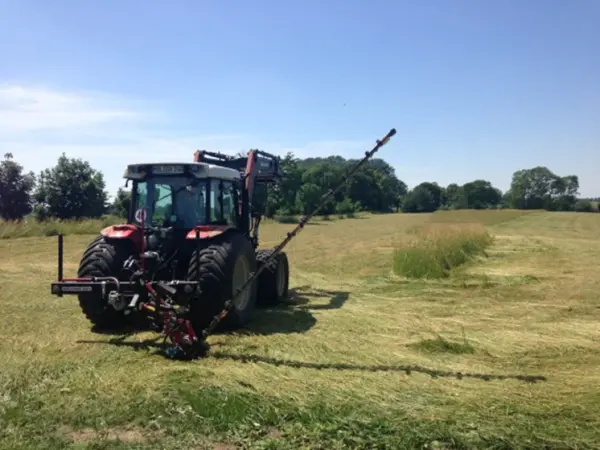Study shows: High costs when using double-blade mowers
Employees of the Eberswalde University for Sustainable Development (HNEE) worked with farmers to analyse the additional costs of using a double-blade mower on nature conservation areas.

Grassland is of outstanding value for biodiversity in our cultural landscape. Thanks to their different plant species, meadows provide habitats for a variety of animals such as birds, reptiles, insects and spiders. For example, grassland that has been used extensively for many years, such as calcareous grassland, is one of the most species-rich biotopes in Central Europe. However, mowing, which on the one hand contributes to the preservation of the diverse flora, on the other hand considerably reduces the fauna of the grassland. This is because each cut with a conventional rotary mower kills between a tenth and a third of the animal population on the mown area.
Past studies have shown that the damage to grassland fauna when using bar and double-blade mowers is significantly lower than when using rotary mowers. While the use of a double-blade mower reduces negative environmental effects on the one hand, practitioners report increasing costs for mowing when using such a mower on the other.
Costs scrutinised
In a practical study, the "Policy and Markets in the Agriculture and Food Sector" working group at HNEE, together with partner farms, investigated the additional costs incurred when using a double-blade mower compared to conventional mowing methods. To this end, all costs associated with the use of the double-blade mower were documented and analysed on two practical farms.
The calculations show that the total costs for the double-blade mower were around twice as high as for conventional mowing technology. On the one hand, higher acquisition costs for the double-blade mower, including the necessary accessories, resulted in additional costs per hectare. These were reflected in both the variable and fixed costs. On the other hand, the required working hours and thus the labour costs were comparatively high. In particular, the frequent changing and sharpening of the blades should be emphasised. This maintenance work was much more extensive than originally expected, especially on nature conservation areas. This is because the composition of the grassland flora on nature conservation areas puts more strain on the blades than on other areas. In addition, the use of a double-blade mower also entails a higher harvesting risk. This is because there is a high probability that mowing will have to be interrupted to change (and sharpen) the blades. This can have a negative impact on forage quality, especially in uncertain weather conditions.
Even if these results were obtained as part of a practical study and cannot be transferred unconditionally to other farms, they clearly show that financial compensation for the use of non-rotary mowing technology is necessary to motivate farmers to use a double-blade mower and thus protect insects and other meadow animals.
"We are particularly pleased that the results of the practical study have already been taken up in Brandenburg. In future, farmers who use a double-blade mower for mowing are to receive €100/ha per year for the areas they mow with a double-blade mower as part of nature conservation-oriented grassland management," explains Ann-Kristin Saurma-Jeltsch, coordinator of the "Schäfer schützen" network.
About the network:
"Schäfer schützen" is a project funded by the Ministry of Agriculture, Environment and Climate Protection with the aim of sustainably strengthening sheep farming in the state of Brandenburg and making the profession of shepherd attractive again. Through an effective exchange of knowledge and increased cooperation between sheep farms, advisory services and science, resource and climate-relevant innovations and their adaptation to the conditions in the state of Brandenburg are to be developed and disseminated.
Note on image material
The photos available here may be used for reporting purposes. Please note the copyright notice © HNEE / Ann-Kristin Saurma-Jeltsch